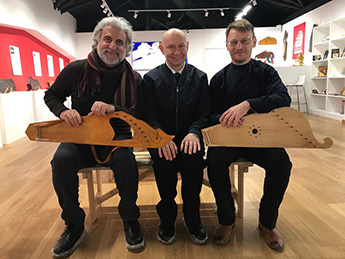The famous Iranian calligrapher Bahman Panahi shared his impressions of visiting the World Calligraphy Museum and the Museum of Russian gusli and Chinese guqin
"For the last ten odd years I have closely followed and participated in the project directed by Mr. Alexey Shaburov: the World Calligraphy Museum. It was thus a great pleasure to finally have the opportunity to visit the museum last February.
From the beginning, I had taken a great interest in this project due to the fact that it promoted and presented the art of calligraphy within its historical and noble contexts. In addition to this, it brought together tradition and modernity in a novel and contemporary approach with the use of today’s means and technology. It was clear that behind all the organisation and efforts of this museum, lay a deep passion and love for the art of calligraphy.
Upon Mr. Shaburov’s invitation, I arranged my trip to Russia essentially to visit the museum and to meet him personally. The day of my visit - a cold day in Moscow with a bit of snow - Mr Shaburov’s warm welcome, accompanied by the energy and the beauty of the calligraphy pieces, made for a memorable experience. It was impressive to see how a medium size museum lodged such a huge variety of styles and genres of calligraphy from the entire world. Most pieces displayed were of high quality and arranged in a logical and careful layout. Mr. Shaburov kindly took the time to explain in detail most of the pieces, as well the particular stories behind his collaboration with different Master calligraphers. This showed his passion and the importance given to each artist present in the museum. It was with particular pleasure that I saw the book of selected Hafez poems, to which I recently contributed, produced by RareBooks in St. Petersburg in a bilingual Russian edition.
We also discussed different matters in relation to collection practices, quality of works, and the criteria used to select new pieces. Mr. Shaburov agreed on the importance of consulting experts and specialists of each calligraphic field in order to ensure the level and development of the collection. At the end of my visit, I was gifted an impressive catalogue of the different private museums in Russia, led by the passion of private collectors and individuals. In turn I gave Mr Shaburov my calligraphy book on selected Rumi poems, published in Paris.
The calligraphy museum was not the end of my visit. To my great surprise, we then proceeded to the museum of traditional Russian folkloric musical instruments, located next to the calligraphy museum and also founded by Mr. Shaburov. Given my dedication to “Musicalligraphy” (the relationship between calligraphy and music), I was doubly pleased, finding my two life-long passions presented side by side in these two museums.
In the musical instruments museum, a musician and master luthier presented us with different examples of Russian folk music and explained the process involved in the manufacture of the musical instruments. This gave rise to a discussion with Mr. Shaburov on a possible “Musicalligraphy” collaboration, including performances and demonstrations of calligraphy from different cultures accompanied by live music.
The visit was finished with a meal in a wonderful restaurant where we had the occasion of savouring the traditional Russian cuisine in a warm and welcoming atmosphere. The following day, the day of my departure, I was surprised by the assistant of Mr Shaburov who gifted me with a traditional musical instrument made by Mr Shaburov himself. Now displayed in my Paris atelier, this instrument is the best souvenir of my trip to Moscow. I trust that this visit will open the path for other collaborations in the future and that we will be able to achieve new projets in the future.
My sincere thanks to Mr. Shaburov for this wonderful trip and especially for all his love and dedication to the art of calligraphy."
Bahman Panahi
Calligraphy is the art of deliberate hieroglyphic corruption and transformation in order to reach natural harmony.







